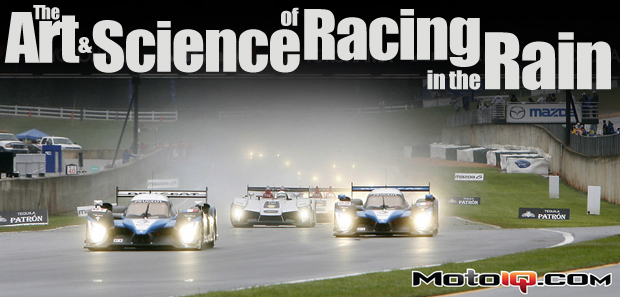,
Because lateral grip is so compromised in the wet, cornering speeds will be lower and weight transfer and body roll reduced. This means that your car does not need as much roll resistance in the wet, allowing you to run your shock settings and swaybar settings much softer than you would in the dry (assuming your car is equipped with adjustable dampers and bars). Pro race teams normally swap in softer springs and swaybars if rain is a certainty, or they'll go with a setup between dry and full wet if rain is a possibility during the race. Softer suspension settings will allow the tires to stay in more constant and consistent contact with the road and that's key to maximizing what little grip is available on a wet surface. Softer suspension settings will also make the car more forgiving to drive, which translates to higher driver confidence and a greater willingness to play on the edge of adhesion.
 |
| In anticipation of a wet CTCC qualifying session at Mosport (one of the fastest road circuits in the world and a real handful in the wet), we swapped in Eibach ERS springs with less than half the rate of our dry setup (450 lb/in down from 1100 lb/in on the rear). We also disconnected the 32mm ASR rear sway bar. |
If you race a FWD or AWD vehicle that tends to understeer a fair bit in the dry, you may be accustomed to trail braking (braking while initiating turn-in for a corner) in order to induce some rotation. However, trail braking in the rain is generally considered a big no-no. In the rain it's always best to brake, turn and accelerate in a deliberate and separate fashion – combine any of these and unless you're a Scandinavian driving god the result can often be a dramatic spin off the track (where all kinds of fun stuff lurks, like tire barriers, armco, or concrete walls). And if you've ever gone off-track in the wet you'll be familiar with the spooky sensation that you're not slowing down much since wet grass is so slick.
 |
| FWD tends to work well in the rain because of the engine's weight being over the drive wheels. |
 |
| AWD works even better, especially when there's an intelligent center diff onboard, but a skilled rain driver will leave the competition in his spray regardless of drivetrain configuration. |
Similarly, in the dry you may be accustomed to using short quick applications of the throttle to adjust the car's attitude in the turns and then jumping on the gas aggressively once you've got the car more or less pointed in the direction of the next straight. In the wet a subtler technique is required, where only smooth and gradual applications of the go-pedal will avoid wheel spin and speed-robbing understeer or oversteer
 |
| Racing a 911 in the rain at the Nurburgring? You'd better be ultra smooth with your inputs, and don't forget to pack some Depends undergarments! Joking aside, 911s work surprisingly well in the rain, especially under acceleration thanks to all that weight over the rear drive-wheels. |



